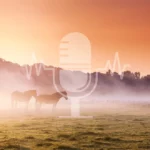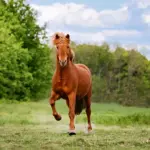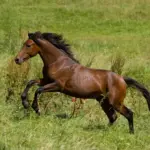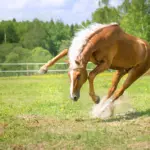Sadly, far too many horse owners are familiar with this: as soon as the pastures are closed, the faecal water starts again. In spring, it’s the other way round: as soon as the horse goes out to pasture, the faecal water seems to magically disappear. Faecal water can have many different causes, so each individual case needs to be looked at carefully.
If horses show no faecal water during the summer when they have extended access to pasture, but it starts again as soon as they are kept in a turn out pen, then three main points should be addressed: forage, gastric ulcers and management – related stress – with possible overlaps between them.
Horses are natural trickle feeders and need constant access to low-energy forage. In our management systems, this means pasture in summer and hay feeding in winter, as most yards don’t have enough grazing to keep horses out all year round.
Hay should be provided in such a way that every horse has access to forage at all times. This means offering enough hay racks or nets, ideally spread out around the turnout area or paddock trail, so that the group can spread out (as they would on pasture) and feed-related rivalry or stress is avoided.
Lower-ranking and older horses in particular benefit greatly when there are several hay stations placed far apart. This allows them to keep their distance from dominant or unsociable horses and eat in peace, reducing management-related stress.
Making forage available in a natural way
Too few forage stations placed close together usually lead to group stress. The same applies to automatic forage dispensers, where each horse is only allowed access for a short period (often around half an hour) before the next one takes its turn.
Here, horses usually bolt their forage frantically in order to get as much as possible in the short time allowed which in turn creates stress. Afterwards, they line up outside again, waiting until it is finally their turn to use the dispenser once more.
These horses spend their day preoccupied with when they will be allowed into the feeder again and how much they can manage to eat in that brief window. Such a routine bears little resemblance to natural management or feeding.
In such cases (whether due to automatic forage feeders or too little hay/too few feeding stations), the horses are exposed to constant stress. Over time this can lead to gastric ulcers at the stomach exit, which cause pain, and, in turn, even more stress.
Constant stress also reduces blood flow to the intestinal lining, leading to inflammation. This in turn causes the normally tight gut wall to develop ‘leaks’ (leaky gut syndrome, disrupted tight junctions), which then shows up as faecal water.
On pasture, horses have constant access to forage and the herd can spread out, which minimises both group and feeding stress. As a result, faecal water often disappears.
The quality of hay has an impact on faecal water
Hay quality also plays a role once horses have developed gastric ulcers. It is often observed that such horses are reluctant to eat coarse, stalky hay — which would normally be considered ideal for them — and that faecal water frequently occurs as a result.

If, on the other hand, soft, leaf-rich (cow) hay is given, horses usually eat it readily and the faecal water disappears. Apparently, the coarse fibres of stalky hay irritate the gastric ulcers, causing additional pain and therefore stress.
Pasture grass is soft and low in fibre, so gastric ulcers are less irritated. This is often another reason why faecal water disappears once the grazing season begins.
Straw is no substitute for hay, as it does not provide enough cellulose to nourish the gut flora. Horses therefore only eat it in limited amounts – and for good reason, as too much can lead to impaction colic. Straw can and should be offered as an additional feed, but not as a replacement for hay. Otherwise, we are back to the problems of feed-related stress and gastric ulcers.
Haylage is also unsuitable as horse feed, as it acidifies the hindgut and thus contributes to the development of dysbiosis (faulty fermentation) and leaky gut syndrome. There are, however, occasional reports from owners who say their horses develop faecal water on hay but not on haylage.
In such cases, a gastric ulcer is usually the underlying problem. To produce good haylage, leaf-rich grasses are needed, which contain relatively little cellulose and are therefore soft and low in fibre.
Together with its considerably higher moisture content, haylage is much softer and therefore irritates gastric ulcers no more than cattle hay (soft, leaf-rich, usually second or third cut) or pasture grass.
However, this does not make it a suitable feed, as the problem of hindgut acidosis still remains — and this can manifest in a wide variety of symptoms, with faecal water being only one of them.
If gastric ulcers are addressed therapeutically in such cases, these horses will also tolerate hay again, allowing the gut flora to be restored to a healthy balance.
Management plays a key role in faecal water during winter
Alongside feeding, management also plays a major role in the development of ‘winter faecal water’.
One of the main advantages of pasture is that it is usually much larger than the winter turnout area, allowing the horses to spread out accordingly.
Studies show that stress levels in horses increase as space becomes more limited. On top of this come other factors such as the assertiveness of the individual horse, the group’s social structure, group size, new introductions or the departure of horses, and many more.
It should never be forgotten that open stables are usually not naturally developed groups, but human-made communities of necessity. Horses are, of course, social animals, but that does not automatically mean they get along with every other horse.
We humans are social beings too, but there are plenty of people we wouldn’t exactly want to share our home and daily life with – and it’s no different for horses.
It is often noticeable that herd groups on pasture suddenly ‘break apart’, with small sub-groups forming. These are often just two to four horses that move around together, going to the shade or the water trough.
Some horses separate themselves completely from the group and prefer to graze alone, keeping only within sight of the others. Such small groups are in fact closer to natural conditions, where wild horse herds often consist of only a few animals. They may come together in larger groups on grazing grounds, for example, but then split up again afterwards.

Integration of newcomers on pasture is therefore usually much more relaxed, as the horses can avoid each other and watch from a distance for a long time before they need to come into close contact.
Such conditions are often not possible on winter turnout areas. If you then have a particularly sensitive horse, a lower-ranking one, an overstrained herd leader, an older horse, or one that, either through years of stabling or simply by nature, places little value on close contact with other horses, these horses end up under constant stress.
There are certainly horses that benefit greatly from being taken out of the group for a time (for example, overnight) and housed individually in a paddock box.
Lower-ranking horses can find rest here and make up for the sleep they have missed during the day. Older horses with dental problems can fill up on soaked hay cobs overnight, while solitary types are glad to escape the social stress of group life for a while.
Not every person is suited to life in a shared flat, and not every horse is happy in shared open housing.
Ground quality
The fact that horses have no faecal water on pasture but do on the turnout area always has valid reasons – and sometimes it takes detective work to track down all the causes and find solutions.
And it is definitely no reason to keep horses on the pastures until November, until it is absolutely no longer possible – especially not after excessively dry summers. Grassland is already under severe stress from excessively hot, drought-like summers, in most regions from winters that are far too dry, and then from yet another dry summer.
The ground is parched, in some places the groundwater level has already dropped, and the horses have been trampling for months on plants that cannot grow properly due to the lack of water.
The more stressed a pasture is, the higher the fructan levels rise – which significantly increases the risk of laminitis, especially now that the nights are getting cooler.
In addition, leaving horses on pasture for too long encourages the displacement of native, low-nutrient grasses and herbs by stress-resistant high-performance grasses that are introduced from other (high-yield) pastures.
That’s why, on most yards, pastures should be closed by the end of September at the very latest, so the fields have a chance to recover.
Where grazing is sparse and there is no possibility of rotating to other fields, hay must already be supplemented on pasture. Otherwise, the risk of horses ingesting poisonous plants increases – which in turn can cause laminitis, atypical myopathy and other potentially fatal diseases. In comparison, faecal water is the lesser evil.










